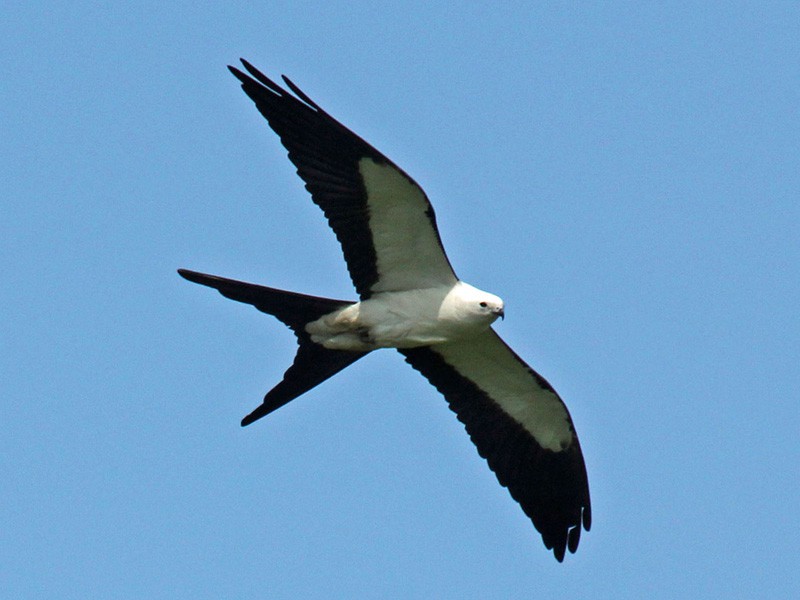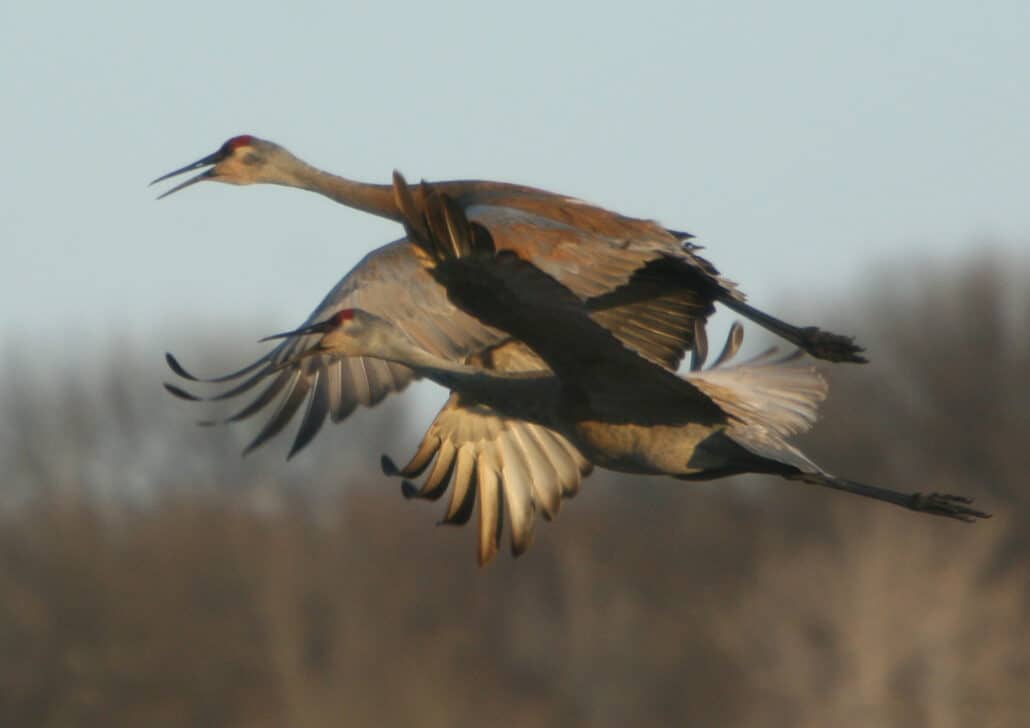1. Red-cockaded Woodpecker

Like many woodpecker species, this one is black and white and of medium size; both sexes have large white cheek patches, and that is a defining field mark. Though the male wears a little red cockade over its auriculars (ears), the cockade is seldom seen. So, while this southeastern woodpecker may be not much to look at, it is delightful to know. In order to do so, you must pay a visit to its home in the forest, one with an open under-story, where the bird lives in venerable old pines, the heartwood of which has been affected by red-heart disease.
Such trees are easy to recognize; though still living, they stand out in a crowd of healthy pines because they are often bare of protective bark, thus giving them a hoary appearance. At closer approach, you will see the woodpecker’s trademark entrance hole (or holes, because there may be cavities from other years in one tree) which seems to have been glazed over with a whitish substance. That is pine gum, and it flows from little “taps” that have been pecked around the main entrance hole (it is believed that this sticky resin repels predators such as rat snakes, and deters competitive cavity nesters from usurping the throne).
Timber is a cash crop and most stands of old pines have been removed. New pines are harvested before they age to meet the housing requirements of the red-cockaded. Because of its precise habitat needs, the red-cockaded woodpecker is one of a growing number of federally endangered species.
Since its plight was recognized, the US Forest Service maintains stewardship of known colonies of this woodpecker; they do this with controlled burns (to assure open understory) and by prohibiting the felling of old pines. Artificial nest boxes have been installed directly into red-heart afflicted old trees, and a number of woodpeckers have been transferred from healthy colonies in Florida to colonies in Mississippi.
Unlike other, more solitary woodpeckers, this one is clannish; it lives in extended family groups and, in common practice, as many as four additional birds will help one pair of adult birds in tending young (bluebirds uncommonly have helpers from previous broods).
Wherever it has suitable habitat, the red-cockaded woodpecker is noisy, and persistently probes the bark of trees for various insects. It is a permanent resident in Mississippi. Though its endangered species status precludes stating specific known colonies, here in Mississippi, Noxubee NWR, the Natchez Trace Parkway, and Homochitto and Desoto National Forests are dependable if one gives it enough time.
2. Brown-headed Nuthatch
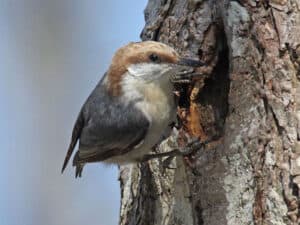
This abundant little nuthatch squeaks like a mouse or a bathtub ducky and is often heard before it is seen. Its home is also in the pine woods, but, unlike the red-cockaded woodpecker (in association with which it is often found) it doesn’t have any persnickety requirements other than a cavity, which both sexes excavate; sometimes they enlarge a natural cavity, or “redo” an old woodpecker hole.
The “brown nut” is resident in southeastern woodlands, hence it is often the object of a search by northern bird watchers. You will do well to learn its call, and to be alert for it in guilds of other woodland birds such as eastern bluebirds, pine warblers, tufted titmice, and Carolina chickadees. It responds to “pssshing” or the imitated calls of a screech-owl, bravely and boldly flying to within inches of one’s face while other birds have cut and run.
It is one of our short-tailed birds, and that feature is as apparent in flying birds as in those who creep slowly among pine cones in topmost branches. Like other nuthatches, they often travel down a tree trunk, and some people call them upside-down birds. The brown-headed nuthatch is white below and has a brown cap and a gray back; if you feel you still need proof of identification, look for the little white scarf on its nape (back of the neck).
Interestingly, this little guy shares some quirks with the red-cockaded and the eastern bluebird; it too sometimes uses helpers at the nest, an unattached male who will feed the female at the nest and feed the young after hatching. Any bird that has smarts enough to use a bark chip as a tool and keep a storehouse of food for the future is well worth your time.
Excepting the northern third and western Mississippi, this bird is most at home in the national forests, but also in any little stretch of mixed pinewoods. Experienced bird watchers would call it “hard to miss,” and you might even lure one to your own feeding station if you serve seeds, nuts, or suet dishes.
3. Bonaparte’s Gull
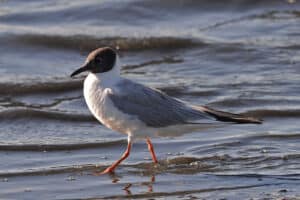
This is the one strictly winter resident among the birds you’ve gotta see. You might wonder why any gull would make this list, but the Bonaparte’s is downright pretty, and a favorite among birders. It is small and delicate. It has a buoyant flight and rides high on the water, appearing more tern-like than gull-like. It doesn’t scrounge around in parking lots and doesn’t beg picnic scraps from strangers on the seawall. One gets the feeling that it definitely prefers the company of its own species; when in groups of mixed gulls and terns, it tends to put some little distance between itself and the big guys, which we might perceive as, and may well be, a certain aloofness.
Though we jest about Bonaparte’s retreat when it disappears at the approach of spring, it isn’t named for Napoleon but for one his distant cousins, Charles Lucien Bonaparte, who was a zoologist. Though it pats its feet in wet sand while searching for marine invertebrates (as many gulls do), we identify the little dance with the “Boney” and we call it the Bonaparte’s shuffle.
It is common from November through March near water throughout Mississippi; one sees it on beaches in the south and looks for it at sewage lagoons and outfalls, over rivers, or feeding in the spillways of the large dams. All Boneys are dressed-down for the winter; first winter and adult winter birds lack the black hoods of breeding adults but otherwise present a pretty picture with their striking wing patterns, short and straight black bills, and cherry-pink feet. The few of this species that hang around through April may reach adult basic plumage (breeding plumage) and are a definite treat for the eyes.
As if Bonaparte’s senses that “different is better” it doesn’t nest on the ground as do most other gulls, but builds, upon a horizontal branch in an evergreen tree, a small platform of sticks lined with grass and moss. This it does in remote areas, from the west and central Canadian provinces and throughout Alaska, as far north as coniferous trees grow.
4. Wood Stork
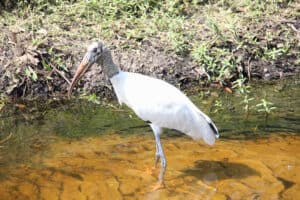
Here we have a non-breeding summer visitor, the only member of its family that occurs in North America, where it has the dubious distinction of being endangered due to destruction of habitat and disruption of water flow in south Florida, where the majority of this species nests.
Like many other colonial nesters, wood storks have a post-breeding dispersal that distributes them far beyond the places where they breed. They are most likely to be seen in Mississippi in August, September, and October. To boost the odds of seeing them, visit Noxubee or St. Catherine NWRs in that time period; St. Cat’s has a definite edge (see the 10 best places for more about that). Almost any other area of fresh water, from the coastal counties to the length of the levee system of the big river, and even refuges in mid-state have been visited by a few wood storks in summer.
This awesome white bird with a black head, glossy black tail, and black flight feathers stands almost as tall as a great blue heron and has a wingspan of 66 inches. On the ground, wood storks move deliberately with necks and legs fully extended; they appear confident and stately while searching for what nature provides in freshwater sloughs, river bottoms, and marshes. In the air, uncoordinated flocks of wood storks flap and sail and soar to great heights, but with none of the unison of movements we associate with soaring flocks of American white pelicans (which also are big white birds with black flight feathers). While white pelicans may be looking for deeper water, wood storks are looking for low water levels and aquatic bounty that provides–fish, amphibians, small reptiles, and crayfish.
Wood storks are bald-faced wonders; they share that attribute with our vultures, and ornithologists have recently changed the taxonomic order of birds (as they appear on recent bird checklists) to make storks and vultures “next-door-neighbors.” The lifestyles of each are decidedly different, but, like the vultures, adult storks make no sound that could be construed as song, although they do hiss and clatter their bills in nesting displays.
5. Magnificent Frigatebird
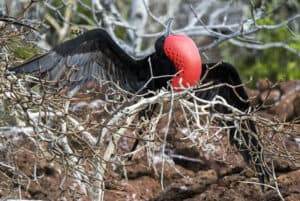
It nests on islands in tropical seas (Marqueses Keys in Florida are the closest), but this rather prehistoric-looking species is another welcome and quite dependable summer visitor to Mississippi waters. It has some bad habits and some unique attributes, all of which makes it fascinating to bird watchers at any level of experience.
Frigatebirds eat fish, hatchling turtles, and the young of other birds—whatever they might pluck from the surface of the water or forage from the air. They are piratic, obtaining much food by stealing it from other more work-oriented seabirds; their colloquial name, man-o-war bird, reflects their penchant for robbery on the high seas.
All frigatebirds have very long, forked tails. The plumages of adult males and females, as well as that of immature birds, are distinct. Adult males come equipped with an inflatable reddish-orange pouch which expands to the size of a big balloon—the better to woo a female.
They nest in colonies on platforms of sticks placed high enough to allow for getting “some wind under their sails” upon takeoff. Their relatively small feet contribute to their awkward movements on land.
In the air it’s a whole different story. The average wingspan of the magnificent frigatebird is a colossal 90 inches—that’s almost 8 feet! It has the longest wings relative to body weight of any other species, and that gives it tremendous buoyancy; it can soar effortlessly above the clouds and it can stay aloft even while sleeping.
To the land bound Mississippi bird watcher, chances to see it may seem as remote as a tropical island, but we are actually in a good place. The shorelines of eastern Harrison County and Jackson County are good vantage points on almost any clear day between late May and late October. Begin the watch about 10 a.m, when thermals have risen; it takes a little patience, but look high, higher than you might look ordinarily, and eventually one or several frigatebirds will come into view.
Major hurricanes have carried these truly magnificent birds far, far inland. If any modest tropical disturbance occurs in the Gulf of Mexico, dozens or even hundreds of birds will actually come in over the mainland, under the clouds, seeming to hang suspended in the air overhead.
6. Reddish Egret

Derek Bakken via Wiki Commons
The reddish egret comes in two colors, white or grayish blue. The white morph (meaning form or variation) is white and it has a bi-colored bill, which is pink, tipped with black. It is much scarcer than the dark morph, which is grayish blue with reddish feathers on its head and neck; it also has a bi-colored bill. It is the dark morph which most often makes an appearance on Mississippi’s beaches.
If it can be said of any bird that it lacks a sense of propriety, then the bird under discussion must be the reddish egret, prince of pratfalls, lord of loose limbs, the clown that does the tanglefooted two-step in the shallows, the one that makes us laugh, the one that makes us wish to be a reddish egret in a parallel life.
Other herons and egrets have a certain dignity; the bird we call “big red” lets it all hang out. What it does is natural—for a reddish egret. When we laugh, we’re responding to a bird making long-legged dashes through the shallows, its body listing first to port and then to starboard, raising its wings like a sail to cast shade on its intended prey, leaping into the air like a dancer in the Ballet Russe, and, finally, lunging at the would-be meal with quick stabbing motions. It may be a hit or it may be a miss, but it is only minutes before the reel rewinds and the show begins again.
Naturally, you will want to see this show as often as you can. In most months one or two reddish egrets are visiting on the barrier islands, but on the mainland we look for it when egrets disperse from their nesting grounds, usually in late July, when each takes up a watch over widely separated sections of beach. There are never many of them, but the few that come to Mississippi from nesting grounds elsewhere (mostly Florida and the Texas coast) tend to stick around until late October and sometimes into winter. Find yourself one, and have a good laugh.
7. Swallow-tailed Kite

Let us be straightforward. The swallow-tailed kite is one of the most beautiful creatures on earth. We should greet each one as a gift from on high. When winter begins its withdrawal from Mississippi in late February, we set our sights skyward and watch for the first swallow-tail of the season. It has a summer home here in the deepest parts of the Deep South, in wooded river swamps ripe with tall cypress trees, without which there might be no swallow-tails at all.
This aerialist was once widespread over the Southeast and north as far as Minnesota. The 20th century seemed to change that. Its breeding range today includes all of Florida and the coastal areas of Georgia, Alabama, Mississippi, and Louisiana. It is a high priority species for anyone who lives outside that range.
It would be an injustice to describe in words what one picture of a soaring kite could say without them. You must fill in the blanks.
Its grace and beauty aside, this kite is more than the sum of its parts. It is gregarious. It migrates in flocks, in spring and in fall. Courtship includes aerial chases and barrel rolls and often involves tossing a stick back and forth as both kites sail effortlessly over the trees. It feeds upon insects, frogs, lizards, snakes and, it is said, the nestlings of small birds (a transgression which we forgive). It obtains most of what it eats and what it feeds its young by swooping down over treetops and plucking creatures out of the leaves and branches.
When nesting duties are over, large numbers of kites congregate over open feeding areas and it is then that the sight of 40 or 50 or more turning lazy circles in the summer sky could strike a hard-nosed skeptic speechless with awe.
If you want to see swallow-tails in spring migration, spend some time on the coast, and keep an eye on the skies on windy days from late February through early April. If you wait for nesting season then you must visit their haunts in the Pascagoula and Pearl River bottomlands. From mid-July through August look over open lands adjacent to the rivers. There is one, or a dozen, swallow-tailed kites in your future.
8. Hooded Warbler
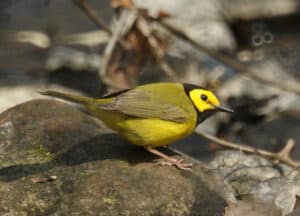
This little sprite is intensely yellow, as befits one of the first neotropical birds to return in spring, often in the first week of March. If you pay attention you will see that birds of a feather seem to arrive in order of good looks and importance—black-helmeted adult males in the lead, adult females next, and then those young of last summer who are making their very first spring migration.
The hooded warbler makes a great first impression. It is a striking bird, and it is pretty up front when in a migrant trap or in the backyard, wherever it has dropped in for a few hours or a few days. Little time passes before it announces itself with some distinctive call notes—a metallic chinking sound. It rules the green world below the four-foot level, showing no fear as it hops about, white-edged tail swishing and flashing like a strobe light.
It is good that you see it before it moves on to greener and wetter woodlands over almost all of the eastern United States. As soon as it establishes territory, announced by song that is loud, clear, and quite musical, this mellow fellow is as visually elusive as the phantom of the opera. It melds into foliage in sun-dappled surroundings and though it may be singing from a perch less than 10 feet away, it is maddeningly inconspicuous.
In Mississippi, the hooded warbler is one of the most common and widespread of the wood-warblers; it nests in wet, dense woodlands from north to south and from east to west. The male is a persistent singer on territory; in late summer, when the imperative for song is over, there are days when the melodious notes still echo from the shadows.
9. Prothonotary Warbler
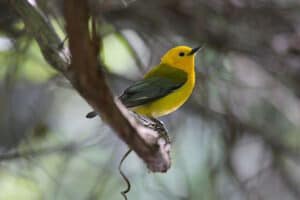
Some migrants come earlier. Some other warblers are as yellow as yellow gets. But none but this beloved torch bearer of spring comes swathed in its own incandescence. Meet the prothonotary warbler. Its eyes are like shiny black onyx beads in a field of purest gold and its wings are soft blue-gray. It needs no other adornments. It is larger, more robust, than other wood-warblers. Whether it comes alone or by the dozen, it commands attention.
The arrival of the “prothos” has a profound and celebratory effect on southern bird watchers. It is as if a drum major blows his whistle and the parade begins. It has nothing to do with degrees of rarity, because the prothonotary is a fairly common bird in the Deep South. It has nothing to do with the timing of migration, because we are already well into it. It has everything to do with our emotional attachment to certain species; believe this, there are few of us who won’t put the protho first.
Prothonotary – the proper pronunciation is PRO-tho-NOTE-ary, though nearly all say pro-THON-o-tary. The literal translation of the name is “for the notary,” and the choice of that name is linked to official scribes (notaries) in the Roman Catholic Church, who wore bright yellow hoods. It’s a big name for a little bird.
Those who want to see this bird will see it. It is widespread during migration and it could be yours to see through a window as it alights upon a twig in your yard. A visit to a migrant trap in the coastal counties in March or early April is sure to light up your life with prothos. A search throughout spring and summer in fresh swamps and wet woodlands statewide could hardly be disappointing.
The prothonotary is the only eastern wood-warbler that nests in cavities, usually natural ones in cypress knees within a swamp. At times it is less discriminating, using a rotting stump, an old woodpecker hole, or a rural mailbox that is near water and convenient to a supply of beetles and spiders. In many places, prothonotary warbler trails are as popular as bluebird trails. LeFleur State Park and Pearl River Waterfowl Refuge in Jackson are two such places. In these days of disappearing swamps and bottomlands that should set an example to all who assume that there will always be enough prothonotaries to satisfy the demand.
10. Painted Bunting

No one is ever fully prepared for the sight of a bird whose combo of colors is at war with the basics of good taste in decorating. The first-time observer is often convinced that the garish little bird is an exotic species, just escaped from an aviary. The hundredth-time observer still feels the need to pick up the phone and tell another similarly afflicted bird watcher that the painted bunting has arrived.
Such is the charisma of the little fellow with the blue head, red eye rings, green back, red chest, and red rump that people have been known to dig in their heels at a productive feeding spot to wait it out, for hours and even days. It matters not that dozens of indigo buntings, blue grosbeaks, even rose-breasted grosbeaks are in the mix, the chance of seeing a painted bunting is what draws the crowd.
That happens most often in a famous migrant trap, such as Dauphin Island in Alabama, where, each morning in late March and early April, the feeding spot at the Shell Mound is strewn with seed and the wait begins. As those who regularly feed birds will attest, a comfy chair with a view to one’s own backyard feeding station is as good a place as any to see what has to be one of the most watched species in North America.
Although it is declining, the painted bunting is not rare within its own range, and Mississippi is part of that range. It breeds sparingly in the coastal counties and in Forrest, Lowndes and Oktibbeha Counties; it is locally common in counties that border the Mississippi River. Thus it is totally within reach of the novice bird watcher.
For a species of such public appeal, the painted bunting isn’t terribly hard to please; it nests among the briers and brush of woodland edges, sometimes in unlikely places such as industrial parks and along railroad rights-of-way; it seems also to like hedges of multi-flora rose. Learn its song and finding a singing male on territory is not quite as daunting as it may seem, but be forewarned that despite its bright colors and the frequency with which it sings its sweet warbling song, the adult male, if not on an exposed perch, might go undetected in the foliage.
As a last thought about the bird among birds that you’ve just gotta see, consider this: beginning bird watchers often overlook less brightly colored females. The female painted bunting is unique and quietly beautiful. In North America she is the only species that could be described as all green (in bright sunlight that could be amended to mean a combination of lemons and limes). Think of her as a royal wife, always 10 steps behind the king.

